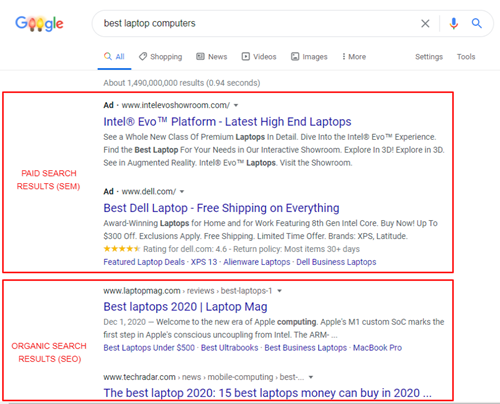What is the Difference Between SEO & SEM?
What’s the Difference Between SEO & SEM?
Search Engine Optimization (SEO) and Search Engine Marketing (SEM) are two important digital marketing strategies that fall under the umbrella of “Search Marketing”, which means that they both focus on generating impressions, traffic and sales via Search Engines like Google.
Each of these search marketing strategies are extremely effective at providing advertisers with positive return on investment, but what’s the difference between SEO and SEM and which channel is right for you?
Here we’ll review what SEO and SEM are, their similarity and differences, when to choose one vs. the other and how to leverage them together to maximize the performance of your search marketing campaigns.

What is SEO?
SEO, or Search Engine Optimization, is an organic search marketing strategy, which means that it focuses on gaining visibility and traffic from Google WITHOUT PAYING for those impressions and clicks.
SEO refers to the process of updating your website according to a series of “SEO best practices” which are capable of earning Google’s trust and convincing the search engine to place your pages at or near the top of their search results for related keyword phrases.
There are a whole series of tasks involved in the SEO process, but for the purposes of this summary introduction to search marketing strategies, all you really need to know about SEO is that it is an organic search marketing strategy that revolves around updating your website’s code, tags and content elements.
SEO Advantages
- SEO is considered “free” since you don’t technically have to spend money to run an effective SEO campaign. The investment for SEO is the time spent updating your website per SEO best practices.
- SEO generates the highest quality traffic on the web, as search users are likely to trust the companies, products and services they find within Google’s organic results, and are less likely to reject the marketing messages found here as manipulative “advertising”.
- SEO is capable of generating long-term, semi-permanent improvements in rankings, which allows brands to capture better organic visibility, more impressions, traffic and sales, even long after they’ve paused SEO efforts.
SEO Weaknesses
- SEO is complicated and intricate. It is more of an “art meets science” type discipline than a science-based SEM strategy, which tends to be easier to measure, test, adjust and optimize since there’s better data available.
- SEO can take a long time to start generating significant results, with competitive keyword phrases requiring up to months or even years worth of work before they start generating performance improvements.
- SEO’s competition level has increased so much in recent years that brand new websites attempting to break into competitive verticals may simply stand no chance of ever gaining good enough rankings to generate organic traffic.
What is SEM?
SEM, or Search Engine Marketing, is a paid search marketing strategy, which means that it seeks to gain visibility and traffic from Google BY PAYING for those impressions and clicks.
SEM may require making updates to your website too, but SEM campaigns can be run without touching the website at all. The core SEM process is instead focused on building targeted advertising campaigns within SEM platforms themselves, which allow you to serve ads in Google’s results, simply by paying for those placements.
Like SEO, SEM is also a complicated process, but for our overview here, what’s important to understand is that SEM is a paid search marketing strategy that revolves around building effective pay-per-click advertising campaigns that allow you to buy traffic from Google.
SEM Advantages
- SEM is extremely fast and capable of generating results within minutes of turning on a campaign. It’s the ideal channel for any organization in a hurry to start seeing results, and a much better option than SEO where speed is a primary consideration.
- SEM is straightforward in that everything involved with the process from the bids to clicks, engagement and sales is perfectly measurable and all within the same system (Google Ads). This allows SEM marketers to easily calculate ROI and optimize based on performance data.
- SEM is incredibly effective. It is Google’s absolute darling product and is likely to produce even better results in the months and years ahead, as this specific marketing channel is almost solely responsible for funding Google’s continued success.
SEM Weaknesses
- SEM is riskier than SEO in that mistakes can cost significant sums of money and there is little wiggle room. Simple mistakes such as forgetting to turn off campaigns, failing to set effective budgets, bidding on the incorrect keywords or failing to generate long enough negative keyword lists can instantly cost tens of thousands of dollars.
- SEM only produces results as long as you continue to pay for the service. The minute you stop spending money with Google, your ads will be pulled from the search results and replaced with a competitor willing to pay for that space you previously occupied.
- SEM may be prohibitively expensive for certain keywords, where costs can run into the hundreds or even thousands of dollars per click. Therefore, if your website doesn’t convert traffic well, certain keyword phrases (or even entire subject areas or verticals) may not be effective from a ROI perspective.
Major Differences Between SEO & SEM
Though both SEO and SEM are search marketing strategies, they differ in several important ways, including:
Perception
SEO offers the ability to serve up content in Google’s “Organic” results, whereas SEM can only provide impressions within their “Paid” results. For certain users, there can be a significant difference in perception between the two marketing strategies. SEO results are less likely to be perceived as advertising (even though they are driven by marketers), whereas SEM results clearly indicate that they are “Ads” and may generate resistance from potential customers who are hesitant or even outright hostile towards ads.
Timing
SEO can take months to develop significant results, whereas SEM is capable of generating an immediate return. Therefore, anyone in a hurry will certainly want to begin with SEM before even considering SEO. One of the best ways to run an integrated search marketing campaign is to begin with SEM, collect the data needed to build an effective SEO strategy, then go to market with SEO efforts knowing you will be able to generate efficient results.
Risk
SEO tends to be less risky, as it can be run “for free” by simply investing time in keyword research, tags and content optimization strategies, whereas each click bought via SEM efforts has an associated cost and some keywords are prohibitively expensive. Making a mistake on the SEO side is highly unlikely to tank marketing results, whereas even basic mistakes from the SEM team can cost huge sums of money.
Data
SEM is capable of generating much more specific data, including keyword-level performance data and robust conversions tracking data, that SEO simply no longer offers (at least directly via Google Analytics). Google purposefully obfuscates SEO data since they want marketers and marketing teams to pay them for the valuable information that can now be collected ONLY via SEM efforts. If your team requires perfect data collection, detailed ROI calculations, etc., then SEM is likely to be the preferred search marketing channel.
Targeting
SEO’s targeting is entirely based around keywords and contextual relevance, essentially using tags and content elements to help set audience targets. There are no filters or custom dimensions that can be used to focus SEO efforts towards specific audiences. SEM, however, provides many audience targeting opportunities, including negative keyword filters, geo-fencing, dayparting and other popular strategies to help focus marketing efforts towards niche audiences.
While there is a significant difference between the SEO and SEM, both channels operate under the same basic and valid assumption; namely, that search traffic is an incredibly valuable source of potential revenue and that it’s worth targeting via sophisticated marketing strategies.
Which Search Marketing Strategy is Right for My Company?
As you might have surmised, SEO and SEM are complementary marketing strategies and search marketing can be best optimized by running both channels together in an integrated fashion.
By combining SEO and SEM best practices, marketers are able to maximize the return on investment from search marketing efforts, delivering a significant incremental additional value that simply couldn’t be accomplished by running the channels separately, in silos.
Search marketing tends to produce the best results when both strategies are used in a complementary fashion, and some of our top tips for ensuring your search campaigns generate maximum return on investment include:
- Informing the SEO keyword targeting and content development strategy with keyword-level performance data from the SEM campaign; especially conversions data
- Using SEO strategies to target keyword phrases that you know are valuable, but which are too expensive to target and turn a positive ROI via SEM efforts
- Updating SEM landing pages via SEO best practices to improve their Google Ads quality scores, allowing you to reduce bids for related keywords
- Capturing two positions on Google’s 1st page for top-priority keyword targets, increasing exposure, allowing you to serve similar marketing message twice (reinforcement), or test running two completely different types of marketing messages (diversity) against the same queries
- Evaluating potential SEO keyword targets and topics first via quick, inexpensive SEM campaigns designed to test keyword performance and gauge conversion potential
Due to the excellent incremental and additional value provided by running both SEO and SEM in a collaborative fashion, it’s foolish to ignore one or the other channel.
Any experienced search marketing expert is likely to advise that you test both channels before eliminating either of them from consideration.
Contact USIM for Help Designing and Implementing an Integrated Search Marketing Strategy
USIM can help improve the results of your search marketing campaigns, as our SEO and SEM departments coordinate their efforts to ensure a collaborative, effective, multi-disciplinary approach to optimizing search marketing efforts.
For details on our approach, please call us at (310) 482-6700, or fill out our Contact Form.
